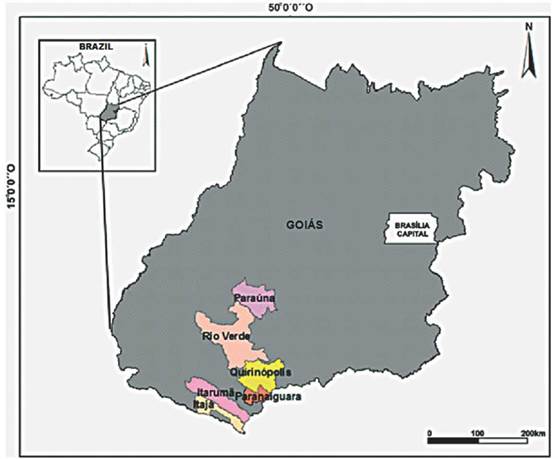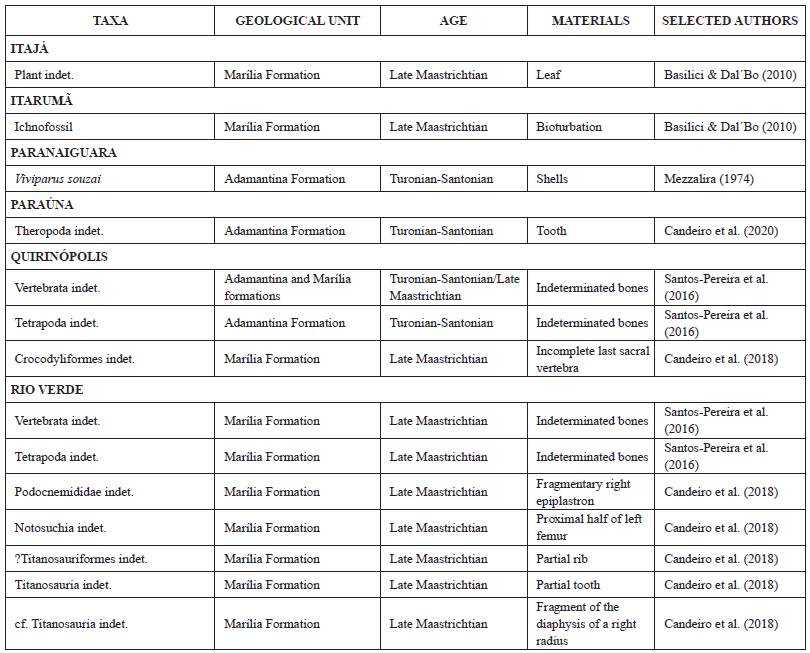Introduction
The southern Goiás state region is located in Central Brazil (Fig. 1), on the borders of the Triângulo Mineiro region (Minas Gerais State), northern Mato Grosso do Sul State, and eastern Mato Grosso State. Some important Federal highways cross the region, connecting it to other Midwest states and the northern, southeastern, and southern regions of Brazil. The state of knowledge of Late Cretaceous fossils from the Bauru Group in southern Goiás state is limited when compared to the Triângulo Mineiro region and western São Paulo State. Nevertheless, in recent years, Goiás state has started to demonstrate its potential as a region that has a diversity of fossil taxa such as invertebrates, ichnofossils, and vertebrates.
In the literature that addresses fossil findings in the southern region of the State of Goiás, little information is available on the Upper Cretaceous fossil records of the Bauru Group, which is the only major unit of the Cretaceous Period that crops out in the south of Goiás (Candeiro et al., 2006). In western São Paulo State and the Triângulo Mineiro region, where many rocks from the Bauru Group outcrop, fossil specimens have been discovered for over 125 years (e.g., Ihering, 1911; Pacheco, 1913; Huene, 1931, 1933; Candeiro et al., 2006; Martinelli & Teixeira, 2015; Candeiro & Figueiroa, 2017; see review in Brusatte et al., 2017). However, these authors have not often been cited in later studies, which have led to misconceptions about the knowledge of the local biota. The gastropod taxon Viviparus souzai Mezzalira, 1974, has been discovered in the municipality of Mateira (currently Paranaiguara municipality), but studies describing other materials such as invertebrates and vertebrates from southern Goiás state were only published after 2013.
The importance of correctly describing the location of deposits and their fossils in their stratigraphic contexts has been previously mentioned by some authors (Resende, 2014; Candeiro et al., 2018). Since the publishing of these works, the existence of two fossil-bearing units have been confirmed and the listing of fauna from southern Goiás state has been significantly updated. Previous studies (e.g., Simone & Mezzalira, 1994; Sema, 2002; Basilici & Dal'Bo, 2010; Dal'Bo & Basilici, 2011; Candeiro et al., 2018) report the presence of fossil records from this region, and therefore, it seems necessary to update the full inventory of fossils.
Weishampel et al. (2004) proposed a summary list of the Late Cretaceous fauna of southern Goiás state and, recently, Basilici & Dal'Bo (2010) and Candeiro et al. (2018) added other taxa to this inventory. Yet, these lists did not consider the problematic history of the fossil record and uncertainties in correlating between formations, which can lead to errors when reconstructing the local biota. The aim of the present study is to present the history of the paleontology of the Bauru Group (Upper Cretaceous) of southern Goiás state, a stratigraphic summary, and the fossil record of the local biota.
Material and methods
The analysis of the documents using the hermeneutic method (i.e. investigating and interpreting the information in the original sources). The hermeneutic method can lead to discoveries, new contributions and critiques, thus expanding our horizon of possibilities.
The data on records of fossiliferous localities used here were mainly based on bibliographic sources and on the direct observation of specimens: (1) the invertebrate specimen was housed at the Instituto Geográfico e Geológico do Estado de São Paulo (currently Instituto Geológico de São Paulo); and (2) specimens deposited under the acronym "Paleontologia da Universidade Federal de Goiás - Coleção de Vertebrados / Paleo-UFG/V" in the Laboratory of Paleontology and Evolution (Laboratório de Paleontologia e Evolução) of the Universidade Federal de Goiás. For the stratigraphic units of the Bauru Group we followed the arrangement proposed by Soares et al. (1980) and the ages suggested by Dias Brito et al. (2001).
Deposition of specimens
Most materials reported from the Bauru Group of southern Goiás state are part of the collection of the Laboratory of Paleontology and Evolution, Universidade Federal de Goiás, since most fossils deposits in this region were discovered by the laboratory's research team. All collection numbers are included in Table 1. The invertebrate reported by Mezzalira (1974) from the municipality of Paranaiguara - Holotype 750-I - is housed at the Instituto Geológico e Geográfico do estado de São Paulo, currently Scientific Collection Sérgio Mezzalira of the Instituto Geológico da Secretaria do Meio Ambiente do Estado de São Paulo. Furthermore, the materials of fossil invertebrates described by Basilici and Dal'Bo (2010) and Dal'Bo and Basilici (2011) are still in situ and, therefore, do not have collection numbers.
Geological setting
The southern part of Goiás state is geologically located in the Bauru Supersequence (Bauru Group), one of the four supersequences that form the Paraná Basin (Milani & Zalan, 1999; Milani et al., 2007; see review in Brusatte et al., 2017). In this region, there is a significant sedimentary record of the Upper Cretaceous that is composed of the Adamantina and Marília formations (sensuSoares et al., 1980).
Soares et al. (1980) proposed an updated stratigraphic system that still applies to the Bauru Group, including, in ascending order from oldest to youngest: the Adamantina, Uberaba, and Marília formations. The Bauru Group rocks crop out in the states of Goiás (south), Minas Gerais (Triângulo Mineiro region), Mato Grosso do Sul (east), and São Paulo (west) (sensuFernandes & Coimbra, 1996).
The Bauru Group outcrops irregularly in southern Goiás state (Fig. 2). Some of the best exposures are in several municipalities (e.g., Caçu, Cachoeira Alta, Itajá, Itarumã, Mineiros, Paranaiguara, Paraúna, Quirinópolis, Rio Verde, and Turvelândia), where the rocks of the Adamantina Formation are superimposed on the Lower Cretaceous basalts of the Serra Geral Formation (Serra Geral Group, Paraná Basin) (sensu CPRM - Serviço Geológico do Brasil, 2004).
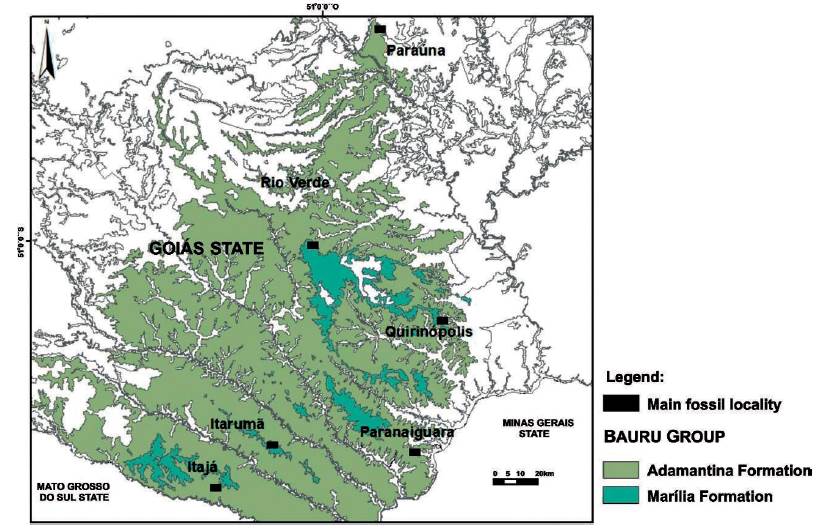
Figure 2 Map showing areal distribution of the Adamantina and Marília formations in southern Goiás state (adapted from CPRM, 2014).
The strata of the Adamantina Formation are composed of reddish fluvial-lacustrine sandstones that were deposited during warm and humid climatic events (Soares et al., 1980; Barcelos, 1984; Barcelos & Suguio, 1987; Fúlfaro et al., 1994; Candeiro et al., 2018). The fossils found in this formation include mainly vertebrates (Santos-Pereira et al., 2016; Ferreira et al., 2016; Gomes, 2017; Simbras et al., 2013; Resende et al., 2014; Candeiro et al., 2016, 2018). The Adamantina Formation was deposited during the Turonian-Santonian intervals based in carophyte and ostracod content (Dias-Brito et al., 2001). et al., 1980; Barcelos, 1984; Barcelos & Suguio, 1987; Fúlfaro etal., 1994). This geological unit is formed by fine to medium sandstones interbedded with levels of conglomerates. The sandstones are cemented and contain calcium carbonate concretions (Fúlfaro & Barcelos, 1991). According to Barcelos & Suguio (1987), the Marília Formation was deposited in an anastomosed river system that produced fine to medium sandstones and lacustrine limestone deposits. In the southern region of Goiás state, this geological unit is the most richly fossiliferous, with records of invertebrates/ichnofossils and vertebrates (Soares et al., 1980; Barcelos & Suguio, 1987; Fúlfaro et al., 1994; Basilici & Dal'Bo, 2010; Dal'Bo & Basilici, 2011). Dias-Brito et al. (2001) assign the Marília Formation to the Late Maastrichtian interval based on the fossil record of ostracods from western São Paulo State and in the Triângulo Mineiro region.
Results
Research history of the Upper Cretaceous of Goiás state and current status of investigations
Although the Bauru Group outcrops occur across many areas of southern Goiás state, there is comparatively few published information on the fossils of the Adamantina and Marília formations in this region. These formations are known for being richly fossiliferous in other states such as São Paulo (western region) and Minas Gerais (Triângulo Mineiro), with records of invertebrates/ ichnofossils and vertebrates. The first paleontological references of Cretaceous fossils from the Bauru Group in the literature were made by Mezzalira (1974) and Bonaparte (1978)(sensu Weishampel, 1993; Weishampel et al., 2004). Weishampel (1993) and Weishampel et al. (2004) reported a probable occurrence of fossil dinosaur remains in southern Goiás state that could be assigned to titanosaurs and theropods.
These materials were supposedly identified by Llewellyn Ivor Price, 1905-1980 (paleontologist of the Serviço Geológico e Mineralógico do Brasil, currently Departamento Nacional da Produção Mineral, Rio de Janeiro, Brazil) (Paulo, 2009). Although Price was possibly the first to acknowledge dinosaur remains in Goiás, Weishampel (1990) mentioned them such as the record ofbones referred as cf. Titanosaurus sp., Antarctosaurus brasiliensis, and Theropoda indet for the first time. According to these authors, the localities where these records were found were mentioned in Bonaparte (1978). Later, Weishampel et al. (2004) suggested that this fossil record was actually represented by ''Antarctosaurus brasiliensis", Lithostrotia indet. (= cf. Titanosaurus sp.), and Theropoda indet., also based on Bonaparte (1978). However, Bonaparte (1978) didn't mention any dinosaur remains from the Goiás state. Based on the work of Weishampel (1993, 2004), many subsequent studies (e.g., Santucci, 2002; Candeiro et al., 2004, 2006) have reported the existence of remains of ' Antarctosaurus brasiliensis" , sauropods, and theropods from the Bauru Group of Goiás state.
The previously mentioned references that indicate the possible existence of titanosaurs and other dinosaur records in Goiás state do not show any information about what kind of fossil specimens are present or their origins, including their stratigraphic provenance. Hence, our understanding of these specimens is mostly speculative, and we cannot verify any details associated with them. So, the references to these specimens do indicate that dinosaur remains might have been found decades ago in the Bauru Group rocks of southern Goiás state, because during the last 120 years the outcrops of this geological unit in other areas of Central Brazil have revealed a rich dinosaur record.
The gastropod Viviparus souzaiMezzalira, 1974 have been described from the rocks of the Adamantina Formation in the municipality of Mateira (currently Paranaiguara). This record is important because it correlates the strata of the Bauru Group in Goiás state with other areas where it crops out, in Minas Gerais and São Paulo states (Simone & Mezzalira, 1994; Senma, 2002). Some authors (e.g., Sema, 2002; Ghilardi et al., 2011a,b) reported that V. souzai came from "Madeira", Goiás state, but its correct locality is Mateira, toponym of the Paranaiguara municipality.
Dal'Bo & Basilici (2009) described the first records of indeterminate trace fossils and bioturbation in the rocks of the Marília Formation, in the municipalities of Itajá and Quirinópolis. Later, Basilici & Dal'Bo (2011) described ichnofossils and other fossils (likely invertebrates) found in the same strata. According to the authors, these materials came from the levels of the Adamantina and Marília formations, i.e., the strata would be indistinguishable in the field, as they are characterized by the same lithofacies, architectural elements, and sequential organization.
In 2013, the research team of the Laboratory of Geology from the Geography Course, Pontal Campus of the Universidade Federal de Uberlândia, initiated research on the Late Cretaceous vertebrates from southern Goiás state. In 2015, this research started to be conducted by the Laboratory of Paleontology and Evolution of the Geology Course, Aparecida de Goiânia Campus of the Universidade Federal de Goiás. The first results were presented in scientific abstracts and in a book chapter (e.g. Simbras et al., 2013; Resende et al., 2014), which described indeterminate remains of sauropod dinosaurs (Simbras et al., 2013). Then, a fossil vertebrate-bearing stratigraphic column of the main deposits from the Quirinópolis and Rio Verde municipalities was presented (Candeiro et al., 2018).
Currently, studies and excavations are ongoing in the above mentioned localities where, today, the main research of our Universidade Federal de Goiás team is concentrated. Our studies have yielded the first formally described reptile fossils from these sites. Furthermore, other materials recovered in these areas are still in preparation (e.g. indeterminate vertebrate remains, turtles, crocodyliforms, sauropods, and theropods). The results have recently published in more than eleven scientific works (Candeiro et al., 2015, 2018, 2020; Santos-Pereira et al., 2016; Souza et al., 2016; Gil et al., 2018; Lima et al., 2018; Monteiro et al., 2018; Gil, 2019; Nogueira & Candeiro, 2019; Maia et al., 2020). The effort of our team over the last few years has made new information available and clarified the Late Cretaceous biota of southern Goiás state.
Biota summary
In order to facilitate understanding, the list of fossil records is divided into four parts: invertebrates and vertebrates from the Adamantina and Marília formations (Fig. 3 and 4). Both Table 1 and Figure 3 show fossil content cited here and the provenance stratigraphic units.
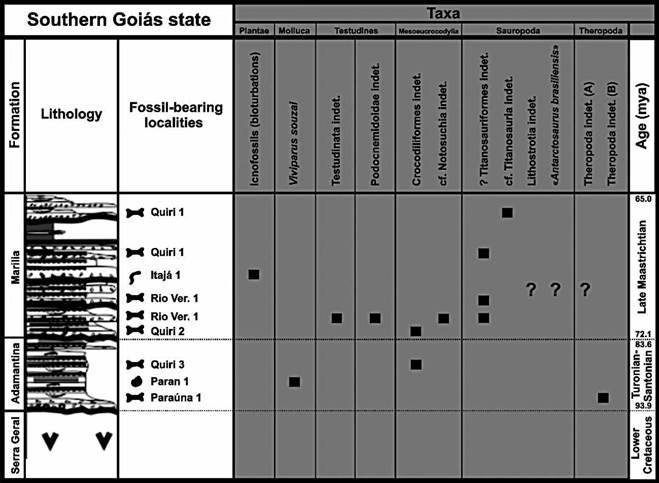
Figure 3 Stratigraphic distribution of Late Cretaceous Bauru Group biota from southern Goiás state, Brazil.
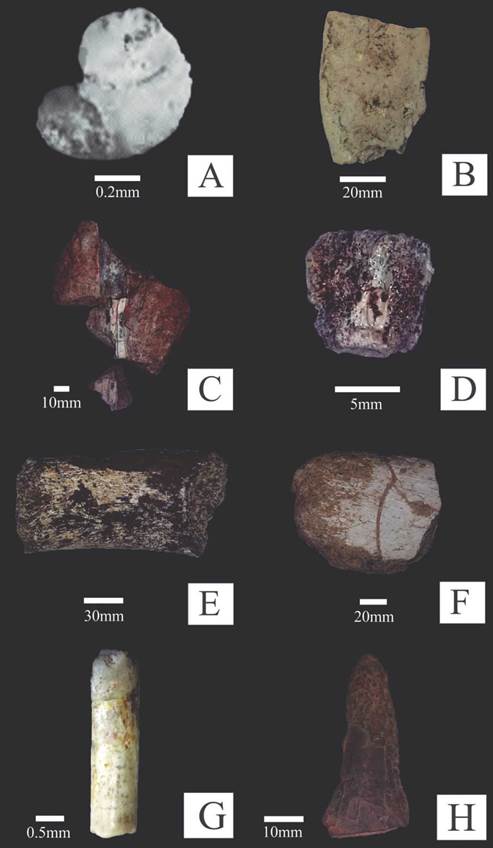
Figure 4 Main faunal taxa reported from Adamantina and Marília formations of southern Goiás state: (A) Viviparus souzai- shell; (B) Podocnemidoidae -fragmentary right epiplastron view. Main faunal taxa reported from the Adamantina and Marília formations of southern Goiás state: (C) cf. Notosuchia indet. - proximal half of a femur in lateral view; (D) Crocodyliformes indet. - last sacral vertebra view; (E) cf. Titanosauria indet. - diaphysis of a right radius; (F) ?Titanosauriformes indet. -partial rib; (G) Titanosauria indet. - fragmented tooth; (H) Theropoda indet. - tooth (A-G from Candeiro et al., 2018 and H from Candeiro et al., 2020).
The three dinosaur taxa from Goiás state mentioned by Weishampel (1993, 2004) -cf. Titanosaurus sp./Lithostrotia indet., "Antarctosaurus brasiliensis", and Theropoda indet.- were not considered in the present study due to the lack of information regarding their provenance, the actual material preserved, and the collection in which they are (or were) housed. In other words, we are unable to verify that these taxa have been discovered in Goiás state.
Some specimens assigned to Tetrapoda indet., Titanosaurifomes indet., and Theropoda indet. are included in the list of taxa here, although they have been described only in papers that were recently submitted or that are in prep, because they are important records of the Bauru Group in Goiás state.
The Turonian-Santonian fossils from the Adamantina Formation
The following vertebrate materials have been reported from the Adamantina Formation:
Locality 1: Paranaiguara municipality. Horizon: Adamantina Formation. Age: Turonian-Santonian. Fossil content: Viviparus souzaiMezzalira, 1974 (Fig. 2). References: Mezzalira (1974), Simone & Mezzalira (1994), Senra (2002), Ghilardi S Maranhão (2010), Ghilardi et al. (2011a, b).
Locality 2: ''Quiri3", Quirinópolis municipality. Horizon: Adamantina Formation (one fossiliferous level). Age: Turonian-Santonian. Fossil content: Vertebrata indet., Tetrapoda indet., Crododylomorpha - Crocodyliformes indet. References: Santos-Pereira et al. (2016), Candeiro et al., (2018, 2019).
Locality 3: ''Paraúna 1", Paraúna municipality. Horizon: Adamantina Formation (one fossiliferous level). Age: Turonian-Santonian. Fossil content: Dinosauria - Theropoda indet. Reference: Candeiro et al. (2019).
The Late Maastrichtian fossils from the Marília Formation
Today, the Marília Formation is the most fossiliferous geological unit in Goiás state and its records include invertebrates, ichnofossils, and vertebrates.
Reference: Basilici & Dal'Bo (2010). Locality 6: ''Rio Ver. 1", Rio Verde municipality. Horizon: Marília Formation (two fossiliferous levels). Age: Late Maastrichtian.
Fossil content: Vertebrata indet., Thetrapoda indet.; Testudines: Podocnemididae; Crododylomorpha indet., Crocodyliformes, cf.; Notosuchia; Dinosauria; Sauropoda; ?Titanosauriformes indet. References: Santos-Pereira et al. (2016), Resende et al. (2014), Candeiro et al. (2018).
Locality 7: ''Quiri 1", Quirinópolis municipality. Horizon: Marília Formation (two fossiliferous levels). Age: Late Maastrichtian. Fossil content: Thetrapoda indet.; Dinosauria: Sauropoda: cf. Titanosauria indet. References: Santos-Pereira et al. (2016), Candeiro et al. (2018).
Locality 8: ''Quiri 2", Quirinópolis municipality. Horizon: Marília Formation (one fossiliferous level). Age: Late Maastrichtian. Fossil content: Vertebrata indet., Thetrapoda indet., Mesoeucrocodylia -Crocodiliformes indet. References: Santos-Pereira et al. (2016), Candeiro et al. (2018).
Locality 4: ''Itajá 1", Itajá municipality. Horizon: Marília Formation (one fossiliferous level). Age: Late Maastrichtian. Fossil content: Invertebrata - ichnofossils. Reference: Basilici & Dal'Bo (2010).
Locality 5: ''Itarumã 1", Itarumã municipality. Horizon: Marília Formation (one fossiliferous level). Age: Late Maastrichtian. Fossil content: Invertebrata - ichnofossils.
Discussion
The present study on the history of the paleontology, stratigraphy, and biota of the Late Cretaceous of southern Goiás state, aims to understand the paleontology of this important but little studied area where the Bauru Group crops out. In the municipalities where the fossil-bearing rocks of the Adamantina and Marília formations crop out in Goiás, the exposures are moderately diverse compared to the outcrops from western São Paulo State and the Triângulo Mineiro region, which are known for being rich in plants, invertebrates, and vertebrates (see fig. 5).
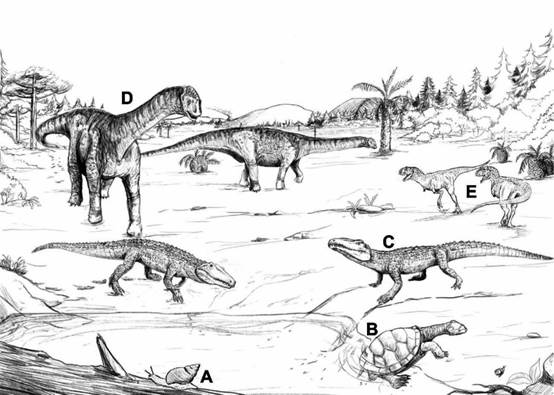
Figure 5 Paleoenvironmental reconstruction of some taxa of the Late Cretaceous Bauru Group from southern Goiás state showing mollusk (A), turtle (B), mesoeucrocodylians(C), titanosaurian (D) and theropod (E). Drawing made by L. Vidal.
Up until recently, Mezzalira (1974) described the only fossil specimen from the Late Cretaceous of the Bauru Group in Goiás state. There is no previously published work that indicates in which geological unit of the Bauru Group Viviparus souzai was discovered. Here, this species was identified from the levels of the Adamantina Formation in the municipality of Paranaiguara. This recognition was made during a field trip in 2015, when it was possible to verify that this is the only formation that crops out in Paranaiguara, an observation corroborated by the mapping from CPRM (2004). This fossil gastropod is important because it correlates the strata of the Adamantina Formation in Goiás state with those of the Triângulo Mineiro region in Minas Gerais State (Senra & Silva, 1999).
The representative tetrapod assemblages from the Late Cretaceous of southern Goiás state have been known, apparently, since the 1940s. Nevertheless, it has been only over the past five years that some of the fossiliferous layers in this region have been studied in detail. This has resulted in a considerable number of identifications of members of the flora and fauna of the Adamantina and Marília formations (see Table 1; fig. 3). Thus far, turtles, crocodyliforms, and dinosaurs are the most abundant groups recovered in these units. The presence of large terrestrial taxa such as mesoeucrocodylians is noteworthy, because these are among the most well-known fossil carnivores of the Late Cretaceous of South America.
The sandstones and mudstones of the Adamantina Formation in the municipality of Quirinópolis occur irregularly in southern Goiás state. Recently, this geological unit was, for the first time, described in detail by Ferreira et al. (2016). The authors described the slopes where a few isolated crocodyliform, dinosaur and theropod remains have been found (Candeiro et al., 2018).
The Late Maastrichtian outcrops of the Marília Formation are the youngest, the most prolific, and most promising fossil-bearing sites from the Late Cretaceous of Central Brazil. A significant quantity of invertebrates and vertebrates have been found in these outcrops, although our work has only recently started. In southern Goiás state, the Marília Formation is mainly formed by white and yellow sandstones with fine sandstone intervals and intraformational conglomerates (Ferreira et al., 2016; Candeiro et al., 2018; Nogueira & Candeiro, 2019; Souza & Candeiro, 2019). The localities 6 and 7 (Quirinópolis, Rio Verde) of this geological unit are the fossil sites that contain the best dinosaurs. Other associated flora and fauna are found in the northeast portion of the Bauru Group in Goiás state.
Some of the vertebrate taxa reported from southern Goiás state were found associated with other vertebrates that are known from other localities that are important for stratigraphic correlation: western São Paulo State (Presidente Prudente, Araçatuba, Adamantina and Marília formations), Triângulo Mineiro region (Adamantina, Uberaba, and Marília formations), and even in Upper Cretaceous rocks of the Neuquén Group (Candeleros, Cerro Lisandro, Portezuelo, Huincul and Bajo de la Carpa formations) and Malargüe Group (Allen and Loncoche formations), both in Argentina (e.g., Leanza et al., 2004; Candeiro & Rich, 2010; Garrido, 2010).
The materials of Podocnemididae, Notosuchia, Titanosauria, and Theropoda, found in the previously mentioned geological units, corroborate this connection with outrcrops of southern Goiás state. Turtles, crocodyliforms, and dinosaurs (especially titanosaurids) have also been found in other areas of the Bauru Group in Minas Gerais and São Paulo states. Regarding the titanosaurian records from the municipalities of Quirinópolis and Rio Verde, these sauropods are widely known in the Upper Cretaceous geological units of Argentina.
The sphenodontids, ornithischians and mammals records from the Late Cretaceous of Argentina is remarkable (e.g., Leanza et al., 2004; de la Fuente et al., 2007). Some of these groups are also found in the Bauru Group of São Paulo State but none have yet been found in the Adamantina and Marília formations of southern Goiás state. The absence of these tetrapods in these areas may be due to the lack of extensive or less systematic prospecting being that the research history in the Adamantina and Marília formations in Goiás state is still recent, but shows a great future potential.
Conclusions
There are reports that Cretaceous dinosaurs were found in southern Goiás state since the 1940s, although these earlier discoveries cannot be verified. Our recent work shows that there is indeed a diversity of fossils in southern Goiás state, from two geological units: the Adamantina (Turonian-Santonian) and Marília (Late Maastrichtian) formations. The fossil fauna of southern Goiás state is similar to that from similar aged deposits in the Triângulo Mineiro region, western São Paulo State, and even Argentina.
Southern Goiás state is a promising area for future finds of Cretaceous fossils, which can be crucialfor the evaluation of biodiversity and biogeographical patterns of tetrapods like dinosaurs and crocodylomorphs during the final part of the Cretaceous, before the end-Cretaceous mass extinction. In short, only a few seasons of fieldwork between the years of 2013 to - 2018 in Goiás state have resulted in a significant addition of new vertebrate records from the Upper Cretaceous of the Bauru Group, hinting that more discoveries are waiting to be made. Our new finds increase the comparative data necessary to understand the faunal composition of Central Brazil and vertebrate distribution in this area during the Cretaceous.













